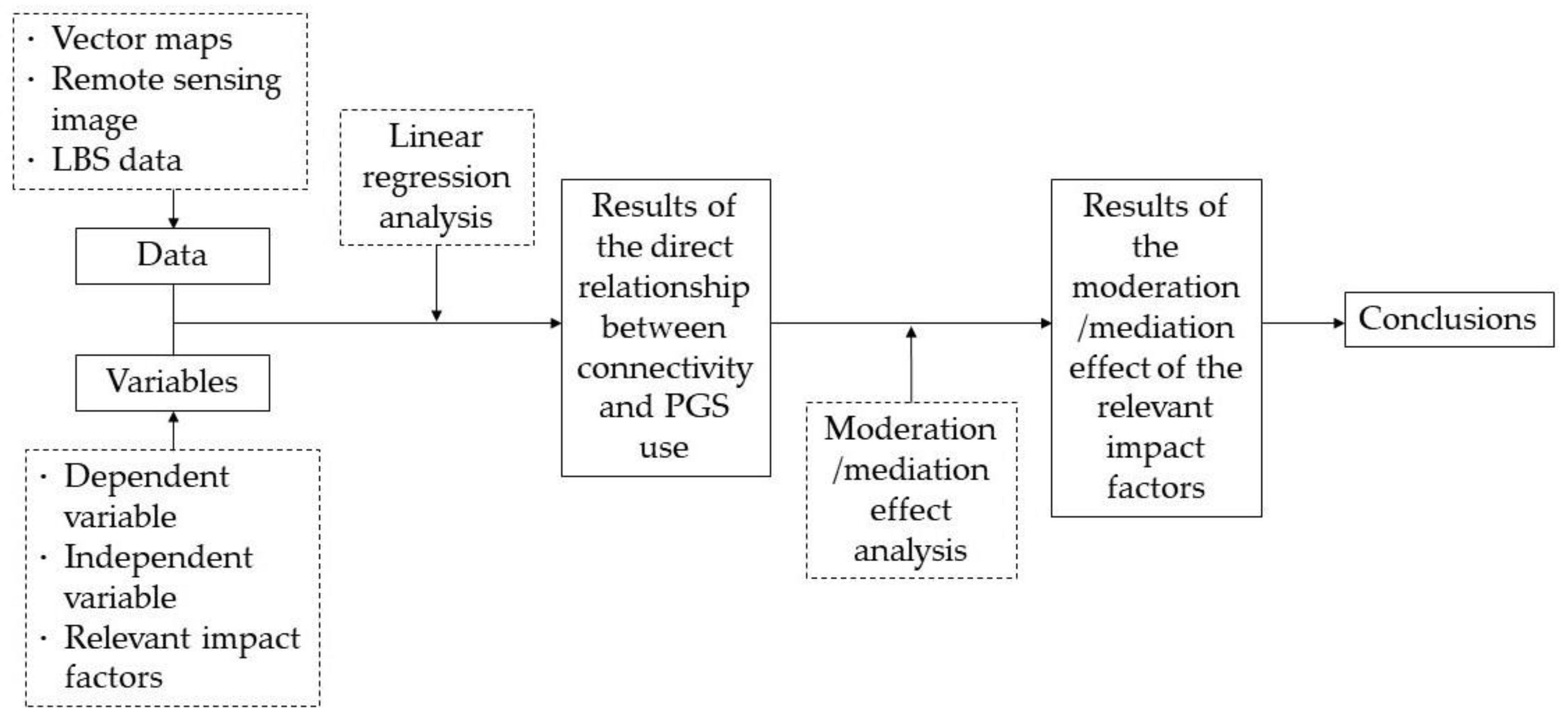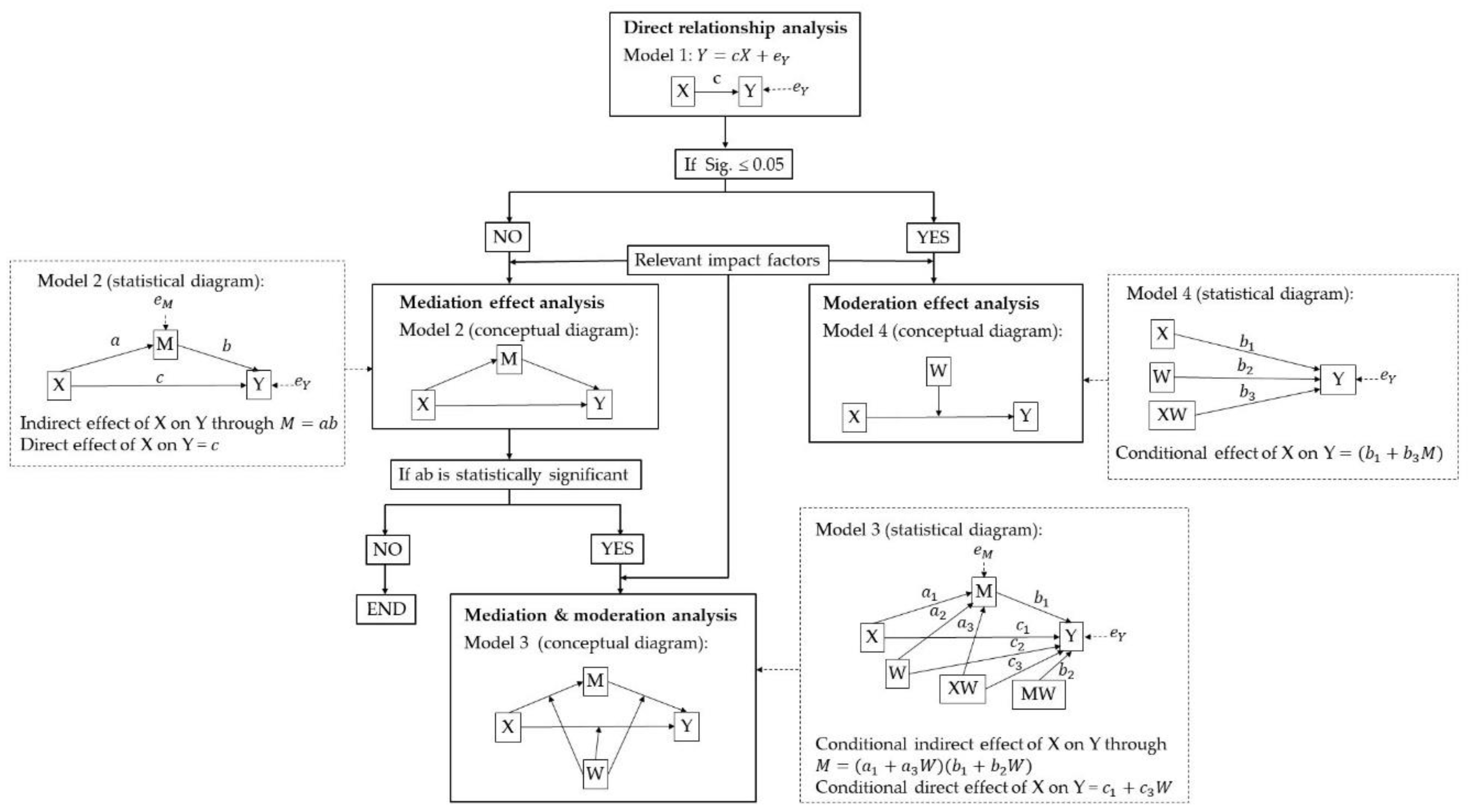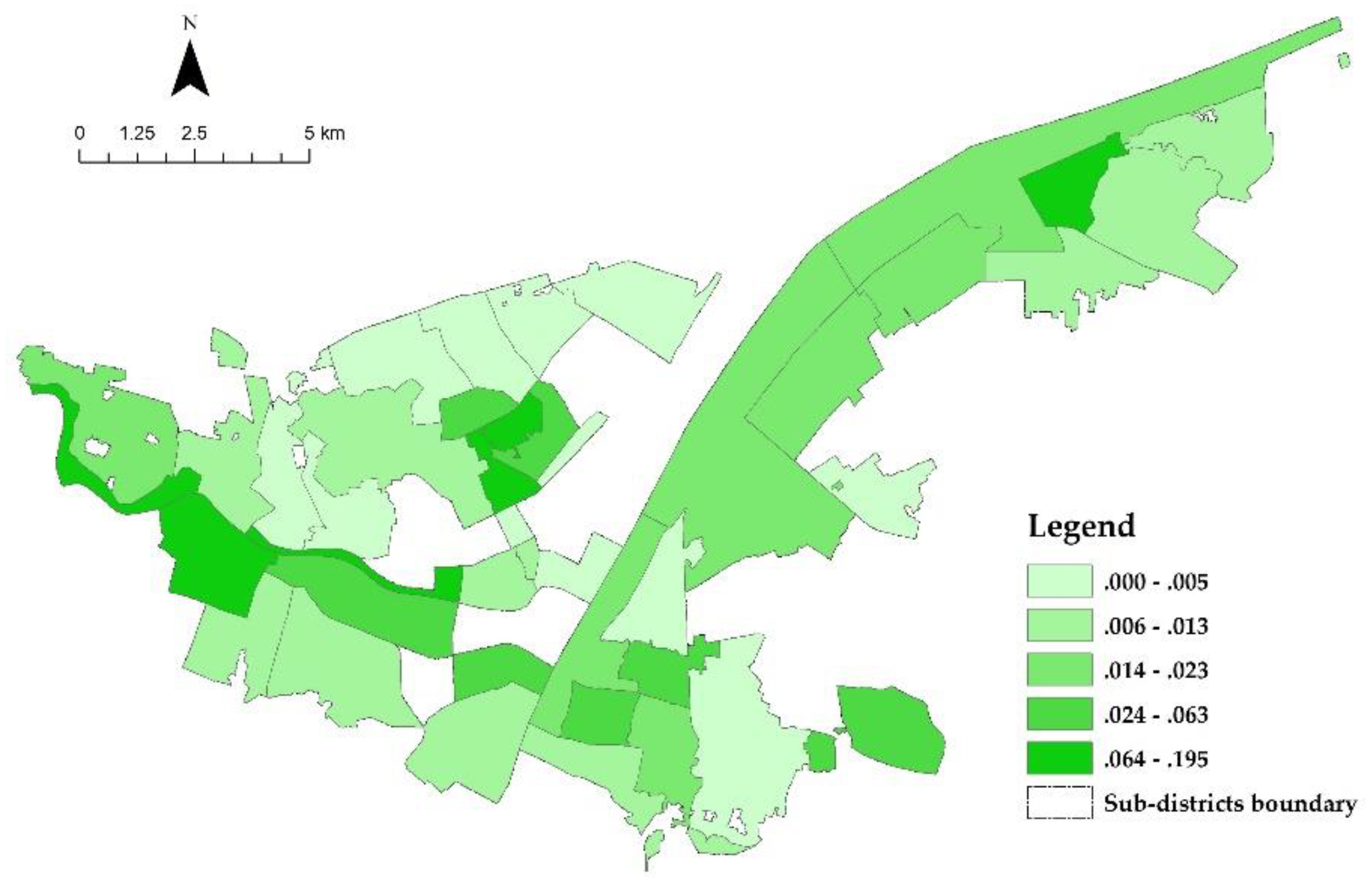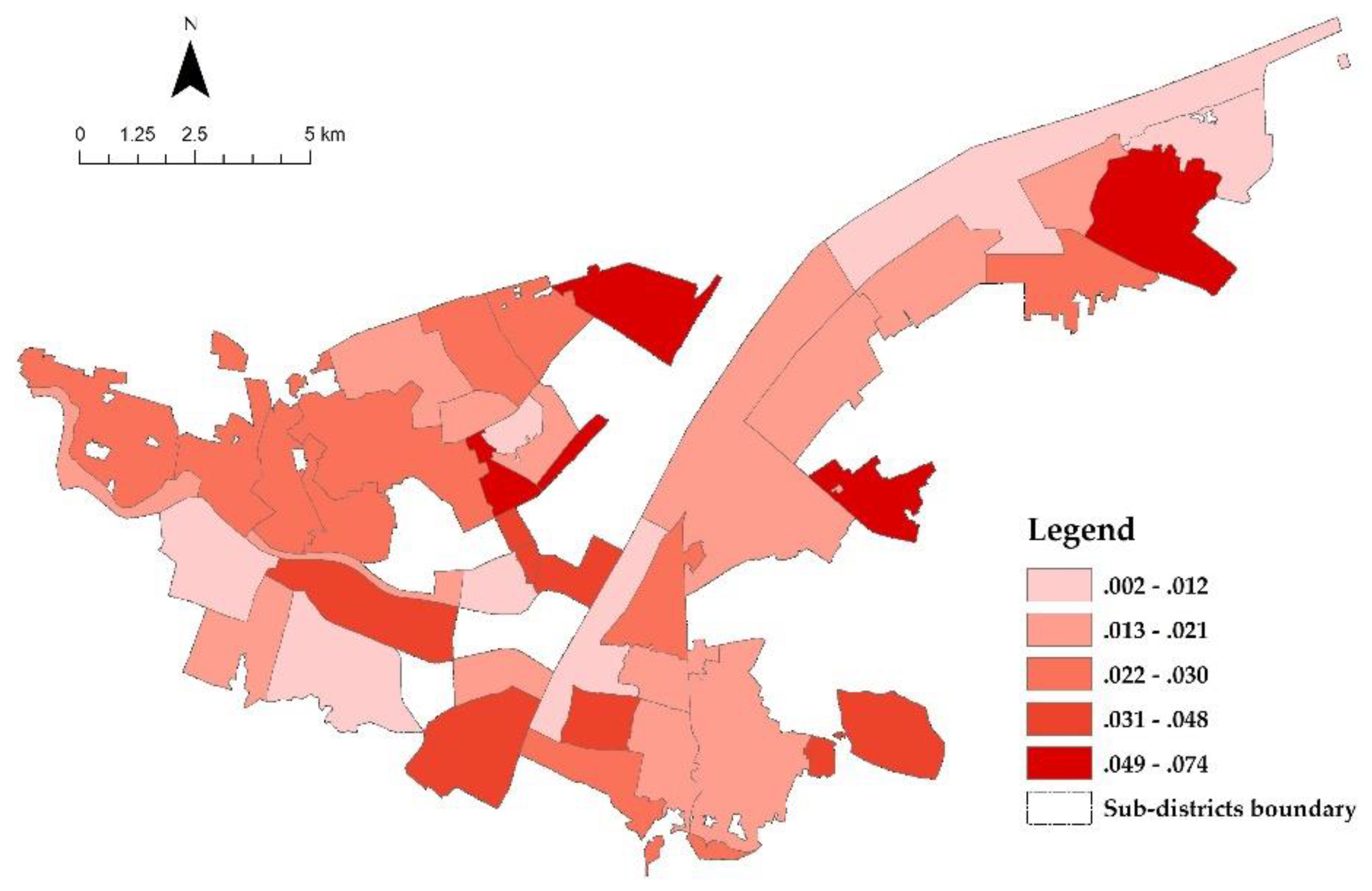Does the Connectivity of Urban Public Green Space Promote Its Use? An Empirical Study of Wuhan
Abstract
:1. Introduction
2. Materials and Methods
2.1. Research Framework
2.2. Study Area
2.3. Indicator Definition
2.3.1. PGS Use
2.3.2. The Connectivity of PGS
2.3.3. Relevant Impact Factors
2.4. Data Collection
2.4.1. Public Green Space
2.4.2. Location Based Services Data
2.4.3. Remote-Sensing Image
2.4.4. Point of Interest Data
2.5. Variable Calculation
2.5.1. Dependent Variable
2.5.2. Independent Variable
2.5.3. Relevant Impact Factors
2.6. Analysis Method
3. Results
4. Discussion
5. Conclusions
Author Contributions
Funding
Acknowledgments
Conflicts of Interest
References
- Dadvand, P.; Villanueva, C.M.; Font-Ribera, L.; Martinez, D.; Basagana, X.; Belmonte, J.; Vrijheid, M.; Grazuleviciene, R.; Kogevinas, M.; Nieuwenhuijsen, M.J. Risks and Benefits of Green Spaces for Children: A Cross-Sectional Study of Associations with Sedentary Behavior, Obesity, Asthma, and Allergy. Environ. Health Perspect. 2014, 122, 1329–1335. [Google Scholar] [CrossRef]
- Astell-Burts, T.; Feng, X.Q.; Kolt, G.S. Mental health benefits of neighbourhood green space are stronger among physically active adults in middle-to-older age: Evidence from 260,061 Australians. Prev. Med. 2013, 57, 601–606. [Google Scholar] [CrossRef]
- Thompson, C.W.; Roe, J.; Aspinall, P.; Mitchell, R.; Clow, A.; Miller, D. More green space is linked to less stress in deprived communities: Evidence from salivary cortisol patterns. Landsc. Urban Plan. 2012, 105, 221–229. [Google Scholar] [CrossRef] [Green Version]
- Barton, J.; Pretty, J. What is the Best Dose of Nature and Green Exercise for Improving Mental Health? A Multi-Study Analysis. Environ. Sci. Technol. 2010, 44, 3947–3955. [Google Scholar] [CrossRef] [PubMed]
- Cohen-Cline, H.; Turkheimer, E.; Duncan, G.E. Access to green space, physical activity and mental health: A twin study. J. Epidemiol. Community Health 2015, 69, 523–529. [Google Scholar] [CrossRef] [PubMed]
- Pate, R.R.; Colabianchi, N.; Porter, D.; Almeida, M.; Lobelo, F.; Dowda, M. Physical activity and neighborhood resources in high school girls. Am. J. Prev. Med. 2008, 34, 413–419. [Google Scholar] [CrossRef] [Green Version]
- Schipperijn, J.; Stigsdotter, U.K.; Randrup, T.B.; Troelsen, J. Influences on the use of urban green space—A case study in Odense, Denmark. Urban For. Urban Green. 2010, 9, 25–32. [Google Scholar] [CrossRef]
- Coombes, E.; Jones, A.P.; Hillsdon, M. The relationship of physical activity and overweight to objectively measured green space accessibility and use. Soc. Sci. Med. 2010, 70, 816–822. [Google Scholar] [CrossRef] [Green Version]
- Han, B.; Cohen, D.; McKenzie, T.L. Quantifying the contribution of neighborhood parks to physical activity. Prev. Med. 2013, 57, 483–487. [Google Scholar] [CrossRef] [Green Version]
- Kondo, K.; Lee, J.S.; Kawakubo, K.; Kataoka, Y.; Asami, Y.; Mori, K.; Umezaki, M.; Yamauchi, T.; Takagi, H.; Sunagawa, H.; et al. Association between daily physical activity and neighborhood environments. Environ. Health Prev. Med. 2009, 14, 196–206. [Google Scholar] [CrossRef] [Green Version]
- Pretty, J.; Peacock, J.; Sellens, M.; Griffin, M. The mental and physical health outcomes of green exercise. Int. J. Environ. Health Res. 2005, 15, 319–337. [Google Scholar] [CrossRef] [PubMed]
- Taylor, A.F.; Kuo, F.E. Children with attention deficits concentrate better after walk in the park. J. Atten. Disord. 2009, 12, 402–409. [Google Scholar] [CrossRef] [PubMed] [Green Version]
- Gidlow, C.J.; Jones, M.V.; Hurst, G.; Masterson, D.; Clark-Carter, D.; Tarvainen, M.P.; Smith, G.; Nieuwenhuijsen, M. Where to put your best foot forward: Psycho-physiological responses to walking in natural and urban environments. J. Environ. Psychol. 2016, 45, 22–29. [Google Scholar] [CrossRef]
- HM Government. A Green Future: Our 25 Year Plan to Improve the Environment. Available online: http://www.gov.uk/government/publications (accessed on 7 December 2019).
- WHO Regional Office for Europe. Urban Green Spaces: A Brief for Action. Copenhagen: World Health Organization, 2017. Available online: http://www.euro.who.int/__data/assets/pdf_file/0010/342289/Urban-Green-Spaces_EN_WHO_web.pdf?ua=1 (accessed on 7 December 2019).
- Xu, X.G.; Duan, X.F.; Sun, H.Q.; Sun, Q.A. Green space changes and planning in the capital region of China. Environ. Manag. 2011, 47, 456–467. [Google Scholar] [CrossRef]
- Kabisch, N.; Qureshi, S.; Haase, D. Human–environment interactions in urban green spaces—A systematic review of contemporary issues and prospects for future research. Environ. Impact Assess. Rev. 2015, 50, 25–34. [Google Scholar] [CrossRef]
- Haaland, C.; van den Bosch, C.K. Challenges and strategies for urban green-space planning in cities undergoing densification: A review. Urban For. Urban Green. 2015, 14, 760–771. [Google Scholar] [CrossRef]
- Thompson, C.W.; Aspinall, P.; Roe, J. Access to green space in disadvantaged urban communities: Evidence of salutogenic effects based on biomarker and self-report measures of wellbeing. In Proceedings of the 2nd AMER Annual International Conference on Quality of Life (AicQol), Kota Kinabalu, Malaysia, 4–5 January 2014; Elsevier Science BV: Amsterdam, The Netherlands, 2014; Volume 153, pp. 10–22. [Google Scholar]
- Richardson, E.A.; Pearce, J.; Mitchell, R.; Kingham, S. Role of physical activity in the relationship between urban green space and health. Public Health 2013, 127, 318–324. [Google Scholar] [CrossRef] [Green Version]
- Vujcic, M.; Tomicevic-Dubljevic, J.; Zivojinovic, I.; Toskovic, O. Connection between urban green areas and visitors’ physical and mental well-being. Urban For. Urban Green. 2019, 40, 299–307. [Google Scholar] [CrossRef]
- Zhang, W.J.; Yang, J.; Ma, L.Y.; Huang, C.H. Factors affecting the use of urban green spaces for physical activities: Views of young urban residents in Beijing. Urban For. Urban Green. 2015, 14, 851–857. [Google Scholar] [CrossRef]
- Jim, C.Y. Green-space preservation and allocation for sustainable greening of compact cities. Cities 2004, 21, 311–320. [Google Scholar] [CrossRef]
- Jim, C.Y. Sustainable urban greening strategies for compact cities in developing and developed economies. Urban Ecosyst. 2013, 16, 741–761. [Google Scholar] [CrossRef] [Green Version]
- Oh, K.; Lee, D.; Park, C. Urban ecological network planning for sustainable landscape management. J. Urban Technol. 2011, 18, 39–59. [Google Scholar] [CrossRef]
- Park, S. A Preliminary Study on Connectivity and Perceived Values of Community Green Spaces. Sustainability 2017, 9, 692. [Google Scholar] [CrossRef] [Green Version]
- Tian, Y.H.; Liu, Y.Q.; Jim, C.Y.; Song, H.Z. Assessing Structural Connectivity of Urban Green Spaces in Metropolitan Hong Kong. Sustainability 2017, 9, 1653. [Google Scholar] [CrossRef] [Green Version]
- Hejkal, J.; Buttschardt, T.K.; Klaus, V.H. Connectivity of public urban grasslands: Implications for grassland conservation and restoration in cities. Urban Ecosyst. 2017, 20, 511–519. [Google Scholar] [CrossRef]
- Sandifer, P.A.; Sutton-Grier, A.E.; Ward, B.P. Exploring connections among nature, biodiversity, ecosystem services, and human health and well-being: Opportunities to enhance health and biodiversity conservation. Ecosyst. Serv. 2015, 12, 1–15. [Google Scholar] [CrossRef] [Green Version]
- Su, Y.N.; Zhang, T.K. Preliminary study on the creation of urban jogging environment—A case study in Shanghai. In Proceedings of the City Ecology·Landscape Architecture·People, Annual Conference of China’s Landscape and Architecture in 2016, Nanning, China, 23 September 2016; China Architecture & Building Press: Beijing, China, 2016. [Google Scholar]
- Snizek, B.; Nielsen, T.A.S.; Skov-Petersen, H. Mapping bicyclists’ experiences in Copenhagen. J. Transp. Geogr. 2013, 30, 227–233. [Google Scholar] [CrossRef]
- Sarkar, C.; Webster, C.; Gallacher, J. Healthy Cities—Public Health through Urban Planning; Edward Elgar: Cheltenham, UK, 2014; pp. 104–105. [Google Scholar]
- Saura, S.; Pascual-Hortal, L. A new habitat availability index to integrate connectivity in landscape conservation planning: Comparison with existing indices and application to a case study. Landsc. Urban Plan. 2007, 83, 91–103. [Google Scholar] [CrossRef]
- Bodin, O.; Saura, S. Ranking individual habitat patches as connectivity providers: Integrating network analysis and patch removal experiments. Ecol. Model. 2010, 221, 2393–2405. [Google Scholar] [CrossRef]
- Brodie, J.F.; Paxton, M.; Nagulendran, K.; Balamurugan, G.; Clements, G.R.; Reynolds, G.; Jain, A.; Hon, J. Connecting science, policy, and implementation for landscape-scale habitat connectivity. Conserv. Biol. 2016, 30, 950–961. [Google Scholar] [CrossRef]
- Thompson, P.L.; Gonzalez, A. Dispersal governs the reorganization of ecological networks under environmental change. Nat. Ecol. Evol. 2017, 1. [Google Scholar] [CrossRef] [PubMed]
- Lynch, A.J. Creating Effective Urban Greenways and Stepping-stones: Four Critical Gaps in Habitat Connectivity Planning Research. J. Plan. Lit. 2019, 34, 131–155. [Google Scholar] [CrossRef]
- Mu, B.; Li, H.W.; Audrey, L.M.; He, R.Z.; Tian, G.X. Dynamic changes of green-space connectivity based on remote sensing and graph theory: A case study in Zhengzhou, China. Acta Ecol. Sin. 2017, 37, 4883–4895. [Google Scholar]
- Clark, N.E.; Lovell, R.; Wheeler, B.W.; Higgins, S.L.; Depledge, M.H.; Norris, K. Biodiversity, cultural pathways, and human health: A framework. Trends Ecol. Evol. 2014, 29, 198–204. [Google Scholar] [CrossRef] [Green Version]
- Li, F.Z.; Dong, S.S.; Li, X.; Lei, Y. Spatial distribution research on the use of green space in the central city of Beijing—Based on the empirical analysis of big data. Chin. Landsc. Archit. 2016, 9, 122–128. [Google Scholar]
- Liu, Y.H.; Zhang, C.; Hou, Y.P. Spatial distribution characteristics of the green space in the main urban area of Wuhan based on large data. Huazhong Archit. 2018, 11, 77–81. [Google Scholar]
- Long, Y.; Zhang, Y.; Cui, C.Y. Identifying commuting pattern of Beijing using bus smart card data. Acta Geogr. Sin. 2012, 10, 1339–1352. [Google Scholar]
- Ahas, R.; Mark, U. Location based services—New challenges for planning and public administration? Futures 2005, 37, 547–561. [Google Scholar] [CrossRef]
- Zook, M.; Dodge, M. New digital geographies: Information, communication, and place. In Geography and Technology; Brunn, S.D., Cuter, S.L., Harrington, J.W., Eds.; Kluwer Academic Publishers: Dordrecht, The Netherlands, 2004; pp. 155–176. [Google Scholar]
- Cai, Y.W.; Zhao, Y.; Ma, X.J.; Zhang, Y. Mobile positioning method for spatial-temporal behavioral data collection and its geographical applications. Areal Res. Dev. 2010, 6, 1–7. [Google Scholar]
- Liu, Y.S.; Zhao, P.J.; Liang, J.S. Study on urban vitality based on LBS Data: A case of Beijing within 6th ring road. Areal Res. Dev. 2018, 37, 64–87. [Google Scholar]
- Yue, Y.; Zhuang, Y.; Yeh, A.G.O.; Xie, J.Y.; Ma, C.L.; Li, Q.Q. Measurements of POI-based mixed use and their relationships with neighbourhood vibrancy. Int. J. Geogr. Inf. Sci. 2017, 31, 658–675. [Google Scholar] [CrossRef] [Green Version]
- Li, F.Z.; Qian, L.X.; Zang, F.Q.; Li, X. Study on recreational use and influencing factors of country parks in Beijing based on Tencent travel big data. Landsc. Archit. 2019, 26, 77–82. [Google Scholar]
- Muhammad, R.; Zhao, Y.L.; Liu, F. Spatiotemporal Analysis to Observe Gender Based Check-In Behavior by Using Social Media Big Data: A Case Study of Guangzhou, China. Sustainability 2019, 11, 2822. [Google Scholar] [CrossRef] [Green Version]
- Statistics Bureau of Hubei Province. Statistical Bulletin of National Economic and Social Development of Wuhan in 2018. Available online: http://tjj.hubei.gov.cn/tjsj/ndtjgb/fzndtjgb/120429.htm (accessed on 10 April 2019).
- Health Survey in Wuhan. Available online: http://hb.sina.com.cn/news/b/2017-04-20/detail-ifyepsch1854190.shtml (accessed on 1 December 2019).
- ‘Healthy Wuhan 2030’ Plan Compendium (Consulation Version). Available online: https://www.qiaokou.gov.cn/xxgk/xxgkml/zfxxgk/ghjh_442/zxgh/201709/t20170911_191943.shtml (accessed on 1 December 2019).
- National Sport Field Area Being 1.57 Square Meter Per Capita in 2016. Available online: https://www.xinhuanet.com/sports/2016-04/07/c_1118559597.htm (accessed on 1 December 2019).
- Song, C.C. Research on the Fairness of the Green Space Service Based on Accessibility: A Case Study of Main Urban Area in Wuhan. Master’s Thesis, Wuhan University, Wuhan, China, 2018. [Google Scholar]
- Xing, L.J.; Liu, Y.F.; Liu, X.J.; Wei, X.J.; Mao, Y. Spatio-temporal disparity between demand and supply of park green space service in urban area of Wuhan from 2000 to 2014. Habitat Int. 2018, 71, 49–59. [Google Scholar] [CrossRef]
- Kazmierczak, A. The contribution of local parks to neighbourhood social ties. Landsc. Urban Plan. 2013, 109, 31–44. [Google Scholar] [CrossRef]
- Maas, J.; Spreeuwenberg, P.; Van Winsum-Westra, M.; Verheij, R.A.; de Vries, S.; Groenewegen, P.P. Is green space in the living environment associated with people’s feelings of social safety? Environ. Plan. 2009, 41, 1763–1777. [Google Scholar] [CrossRef] [Green Version]
- Sugiyama, T.; Leslie, E.; Giles-Corti, B.; Owen, N. Associations of neighbourhood greenness with physical and mental health: Do walking, social coherence and local social interaction explain the relationships? J. Epidemiol. Community Health 2008, 62. [Google Scholar] [CrossRef] [PubMed] [Green Version]
- Pascual-Hortal, L.; Saura, S. Comparison and development of new graph-based landscape connectivity indices: Towards the priorization of habitat patches and corridors for conservation. Landsc. Ecol. 2006, 21, 959–967. [Google Scholar] [CrossRef]
- WHO. Urban Green Space and Health: A Review of Evidence; WHO: Geneva, Switzerland, 2016. [Google Scholar]
- Dong, Y.P.; Liu, H.L. Reframing the index system of urban green space planning toward public health in China: Problems and solutions. Cities Health 2019. [Google Scholar] [CrossRef]
- Geng, H.Z.; Zhu, L.; Yang, C.X. Research on urban vitality of public green space in Lujiazui center district, Shanghai. Urban. Archit. 2017, 16, 21–23. [Google Scholar]
- Park, J.Y.; Shin, H.K.; Choi, J.S.; Oh, H.S.; Choi, K.H.; Park, S.M.; Cho, B. Do People Have Healthier Lifestyles in Greener Environments? An Analysis of the Association between Green Environments and Physical Activity in Seven Large Korean Cities. Korean J. Fam. Med. 2013, 34, 58–63. [Google Scholar] [CrossRef] [PubMed]
- Dong, Y.P.; Liu, H.L. Health-oriented evaluation of the spatial distribution of urban green space in the Wuhan inner city area of China. In Proceedings of the WIT Transactions on the Built Environment, Seventh International Conference on Harmonization between Architecture and Nature, Brockenhurst, UK, 2–4 October 2018; Syngellakis, S., Ed.; WIT Press: Southampton, UK, 2018; Volume 184, pp. 37–48. [Google Scholar]
- Zhang, X.W.; Li, Z.D.; Wang, J.L.; Zhao, C.L.; Liu, Y. Analysis of the ratio of arbor to shrub of several types of green space in Beijing. J. Beijing For. Univ. 2010, 32 (Suppl. S1), 183–188. [Google Scholar]
- Van den Bosch, M.A.; Mudu, P.; Uscila, V.; Barrdahl, M.; Kulinkina, A.; Staatsen, B.; Swart, W.; Kruize, H.; Zurlyte, I.; Egorov, A.I. Development of an urban green space indicator and the public health rationale. Scand. J. Public Health 2016, 44, 159–167. [Google Scholar] [CrossRef] [PubMed]
- Liu, M.H.; Shao, Y.; Li, X.X. Remote sensing monitoring of land desertification based on vegetation index and surface albedo. J. Shenyang Jianzhu Univ. (Nat. Sci.) 2019, 35, 512–518. [Google Scholar]
- Zhao, B.J.; Wang, H.F.; Zhang, A.B.; Cao, Y.; Liu, H.L. Inter-sensor comparison and quantitative relationships between GF-1 WFV and Landsat 8 OLI NDVI data. J. Geomat. 2019, 44, 60–65. [Google Scholar]
- Ke, Y.H.; Im, J.; Lee, J.; Gong, H.L.; Ryu, Y. Characteristics of Landsat 8 OLI-derived NDVI by comparison with multiple satellite sensors and in-situ observations. Remote Sens. Environ. 2015, 164, 298–313. [Google Scholar] [CrossRef]
- Xu, Z.N.; Gao, X.L. A novel method for identifying the boundary of urban built-up areas with POI data. Acta Geogr. Sin. 2016, 71, 928–939. [Google Scholar]
- Shi, H.; Xu, Y.N. Research on planning method of urban green space core region based on landscape connectivity. J. Nanjing For. Univ. (Nat. Sci. Ed.) 2011, 35, 51–56. [Google Scholar]
- Saura, S.; Torne, J. Conefor Sensinode 2.2: A software package for quantifying the importance of habitat patches for landscape connectivity. Environ. Model. Softw. 2009, 24, 135–139. [Google Scholar] [CrossRef]
- Almanza, E.; Jerrett, M.; Dunton, G.; Seto, E.; Pentz, M.A. A study of community design, greenness, and physical activity in children using satellite, GPS and accelerometer data. Health Place 2012, 18, 46–54. [Google Scholar] [CrossRef] [Green Version]
- McMorris, O.; Villeneuve, P.J.; Su, J.; Jerrett, M. Urban greenness and physical activity in a national survey of Canadians. Environ. Res. 2015, 137, 94–100. [Google Scholar] [CrossRef] [PubMed]
- Liu, G.C.; Wilson, J.S.; Qi, R. Green neighborhoods, food retail and childhood overweight: Differences by population density. Am. J. Health Promot. 2007, 21, S317–S325. [Google Scholar] [CrossRef] [PubMed]
- Wuhan Municipal Green Committee Office. Wuhan Greening Status Bulletin in 2017. Available online: http://cjrb.cjn.cn/html/2018-03/12/content_62942.htm (accessed on 10 April 2019).
- Chen, R.; Zheng, Y.H.; Liu, W.J. Mediation analysis: Principles, procedures, bootsrap methods and application. J. Mark. Sci. 2013, 9, 120–135. [Google Scholar]
- Lu, Y.C.; Fang, S.M. Study on the spatial distribution optimization of park green spaces in the main city of Wuhan from the perspective of both equilibrium and efficiency. Resour. Environ. Yangtze Basin 2019, 1, 68–79. [Google Scholar]
- Cohen, D.A.; Marsh, T.; Williamson, S.; Han, B.; Derose, K.P.; Golinelli, D.; McKenzie, T.L. The potential for pocket parks to increase physical activity. Am. J. Health Promot. 2014, 28, S19–S26. [Google Scholar] [CrossRef] [Green Version]
- Tilt, J.H.; Unfried, T.M.; Roca, B. Using objective and subjective measures of neighborhood greenness and accessible destinations for understanding walking trips and BMI in Seattle, Washington. Am. J. Health Promot. 2007, 21, 371–379. [Google Scholar] [CrossRef]
- Li, J.Q.; Yang, H.T.; Zhu, C.Y. Analysis of the park green space on the usage of recreation space in Wuhan. Huazhong Archit. 2013, 11, 127–131. [Google Scholar]
- WeChat Team, WeChat Annual Data Report in 2018. Available online: https://www.bianews.com/news/details?id=29244&type=0 (accessed on 10 April 2019).
- Lottrup, L.; Grahn, P.; Stigsdotter, U.K. Workplace greenery and perceived level of stress: Benefits of access to a green outdoor environment at the workplace. Landsc. Urban Plan. 2013, 110, 5–11. [Google Scholar] [CrossRef]
- Lottrup, L.; Stigsdotter, U.K.; Meilby, H.; Corazon, S.S. Associations between use, activities and characteristics of the outdoor environment at workplaces. Urban For. Urban Green. 2012, 11, 159–168. [Google Scholar] [CrossRef]
- Largo-Wight, E.; Chen, W.W.; Dodd, V.; Weiler, R. Healthy workplaces: The effects of nature contact at work on employee stress and health. Public Health Rep. 2011, 126, 124–130. [Google Scholar] [CrossRef] [Green Version]
- Gilchrist, K.; Brown, C.; Montarzino, A. Workplace settings and wellbeing: Greenspace use and views contribute to employee wellbeing at pen-urban business sites. Landsc. Urban Plan. 2015, 138, 32–40. [Google Scholar] [CrossRef]






| Category | Variables | Description | Data Source | Type | |
|---|---|---|---|---|---|
| Special Data | Basic Data | ||||
| Independent variable | the connectivity of PGS in each sub-district | measured by IIC | GS distribution | sub-district distribution | numeric |
| Dependent variable | PGS use | measured by relative population density of PGS within each sub-district | Wechat-Yichuxing; GS distribution; residents within each sub-district | ||
| Impact factors | Green space characteristics | ||||
| the greenness of each sub-district | measured by mean NDVI | remote sensing image from Landsat8 (OLI_TIRS) on 23 July 2016 with 30m * 30 m | |||
| the quality of PGS | measured by RAS | ||||
| the availability of PGS | measured by PGSAPC | GS distribution; residents within each sub-district | |||
| Facility function characteristics | |||||
| Facilities for living | measured by the density of residence | residence POI | |||
| measured by the density of LSF | LSF POI | ||||
| measured by the density of CF | CF POI | ||||
| measured by the density of SF | SF POI | ||||
| Facilities for working | measured by the density of company | company POI | |||
| Facilities for education | measured by the density of school | school POI | |||
| Facilities for entertainment | measured by the density of SLF | SLF POI | |||
| Variables | N | Range | Minimum | Maximum | Mean | Std. Deviation | Variance | |
|---|---|---|---|---|---|---|---|---|
| Statistic | Statistic | Statistic | Statistic | Statistic | Std. Error | Statistic | Statistic | |
| IIC | 42 | 0.194 | 0.000 | 0.195 | 0.029 | 0.007 | 0.042 | 0.002 |
| PGS use | 42 | 0.071 | 0.002 | 0.074 | 0.028 | 0.003 | 0.018 | 0.000 |
| NDVI | 42 | 0.780 | −0.213 | 0.567 | 0.267 | 0.026 | 0.166 | 0.028 |
| RAS | 42 | 1.201 | 0.000 | 1.201 | 0.363 | 0.037 | 0.238 | 0.057 |
| PGSAPC | 42 | 34.640 | 0.210 | 34.850 | 7.273 | 1.244 | 8.062 | 64.993 |
| density of CF | 42 | 5.538 | 0.118 | 5.656 | 1.276 | 0.152 | 0.985 | 0.970 |
| density of LSF | 42 | 1.931 | 0.039 | 1.970 | 0.501 | 0.058 | 0.374 | 0.140 |
| density of residence | 42 | 1.033 | 0.020 | 1.053 | 0.320 | 0.035 | 0.228 | 0.052 |
| density of SF | 42 | 2.155 | 0.066 | 2.221 | 0.668 | 0.068 | 0.440 | 0.193 |
| density of company | 42 | 5.607 | 0.106 | 5.713 | 1.067 | 0.167 | 1.081 | 1.169 |
| density of school | 42 | 0.576 | 0.008 | 0.583 | 0.103 | 0.016 | 0.102 | 0.010 |
| density of SLF | 42 | 0.972 | 0.013 | 0.985 | 0.330 | 0.033 | 0.214 | 0.046 |
| Valid N (listwise) | 42 | |||||||
| Model Summary | |||||
|---|---|---|---|---|---|
| R | R Square | Adjusted R Square | Std. Error of the Estimate | Durbin–Watson | Variables |
| 0.134 | 0.018 | −0.007 | 0.01827 | 2.027 | Y: PGS use; X: IIC |
| ANOVA | |||||
| Sum of Squares | df | Mean Square | F | Sig. | |
| Regression | 0.000 | 1 | 0.000 | 0.734 | 0.397 |
| Residual | 0.013 | 40 | 0.000 | ||
| Total | 0.014 | 41 | |||
| Coefficients | |||||
| Unstandardized Coefficients | Standardized Coefficients | t | Sig. | ||
| B | Std. Error | Beta | |||
| (Constant) | 0.000 | 0.003 | 0.000 | 1.000 | |
| IIC | −0.058 | 0.068 | −0.134 | −0.857 | 0.397 |
| Variables | Direct effect of X on Y | Indirect effect(s) of X on Y | ||||||
|---|---|---|---|---|---|---|---|---|
| X and Y | M | Effect | p | LLCI | ULCI | Effect | BootLLCI | BootULCI |
| X: IIC; Y: PGS use | PGSAPC | −0.026 | 0.733 | −0.176 | 0.125 | −0.032 | −0.100 | 0.105 |
| RAS | −0.058 | 0.405 | −0.197 | 0.081 | 0.000 | −0.036 | 0.029 | |
| NDVI | −0.055 | 0.422 | −0.191 | 0.082 | −0.003 | −0.043 | 0.021 | |
| density of CF | −0.061 | 0.365 | −0.196 | 0.074 | 0.003 | −0.026 | 0.043 | |
| density of LSF | −0.071 | 0.295 | −0.205 | 0.064 | 0.013 | −0.031 | 0.059 | |
| density of residence | −0.067 | 0.333 | −0.205 | 0.071 | 0.009 | −0.026 | 0.035 | |
| density of school | −0.060 | 0.379 | −0.198 | 0.077 | 0.003 | −0.014 | 0.027 | |
| density of SF | −0.059 | 0.387 | −0.195 | 0.077 | 0.001 | −0.033 | 0.024 | |
| density of SLF | −0.089 | 0.212 | −0.230 | 0.053 | 0.031 | −0.030 | 0.101 | |
| density of company | −0.121 | 0.070 | −0.252 | 0.011 | 0.063 | −0.046 | 0.206 | |
| OUTCOME VARIABLE: PGS Use | ||||||
|---|---|---|---|---|---|---|
| Model Summary | ||||||
| R | R−sq | MSE | F | df1 | df2 | p |
| 0.4536 | 0.2058 | 0.0003 | 5.0528 | 2 | 39 | 0.0112 * |
| Model | ||||||
| coeff | se | t | p | LLCI | ULCI | |
| constant | 0 | 0.0026 | 0 | 1 | −0.0052 | 0.0052 |
| IIC | −0.121 | 0.065 | −1.8617 | 0.0702 | −0.2524 | 0.0105 |
| density of company | 0.0077 | 0.0025 | 3.0365 | 0.0043 ** | 0.0026 | 0.0128 |
© 2020 by the authors. Licensee MDPI, Basel, Switzerland. This article is an open access article distributed under the terms and conditions of the Creative Commons Attribution (CC BY) license (http://creativecommons.org/licenses/by/4.0/).
Share and Cite
Dong, Y.; Liu, H.; Zheng, T. Does the Connectivity of Urban Public Green Space Promote Its Use? An Empirical Study of Wuhan. Int. J. Environ. Res. Public Health 2020, 17, 297. https://doi.org/10.3390/ijerph17010297
Dong Y, Liu H, Zheng T. Does the Connectivity of Urban Public Green Space Promote Its Use? An Empirical Study of Wuhan. International Journal of Environmental Research and Public Health. 2020; 17(1):297. https://doi.org/10.3390/ijerph17010297
Chicago/Turabian StyleDong, Yuping, Helin Liu, and Tianming Zheng. 2020. "Does the Connectivity of Urban Public Green Space Promote Its Use? An Empirical Study of Wuhan" International Journal of Environmental Research and Public Health 17, no. 1: 297. https://doi.org/10.3390/ijerph17010297





